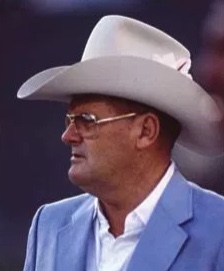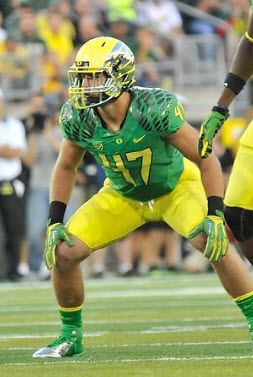In an effort to help us understand the FishDuck.com analysis articles going forward, it helps to have an understanding of how an offense views gaps at the line of scrimmage, and how a defense will line up in numbered alignments, or as coaches will call techniques correspondent to those gaps. Using the illustration below, let’s get started learning about what the different gaps (letters in white) and numbered alignment/techniques (numbers in yellow) mean, and why they’re used.

The top numbers are techniques, and the bottom letters are gaps.
Gaps are the spaces in between the splits of the offensive linemen. The center-guard gap is the A-gap, guard-tackle is the B-gap, tackle-tight end(s) is the C-gap, and outside the tight end is the D-gap.
The offense makes reference to these gaps in their design of plays and for instruction purposes. The defense looks to fill these gaps versus the run, or put another way, to “fit” a player into each gap. When a defensive player over-pursues, is late to fill or isn’t assignment sound, the defense has lost “gap integrity” on the play, which creates running lanes for the offense.

DeForest Buckner
It gets confusing on defense for fans, as coaches use the numbered alignment positions and the word “techniques” interchangeably. For example a coach will refer to a “3-Technique” when he is thinking about what that player will be doing on the field, while we fans are thinking he is referring to the alignment the defender is lined up in.
Technique actually refers to the specific tasks that player aligned in that spot on the defensive line will carry out for that particular coach or defense. It entails a ton of details and assignments for that particular player thus coaches have reduced it down to call it a “technique.”
In the spirit of being accurate and helping the fan learn–we should refer to them as “alignments” since we are talking about where the defenders line up on the defensive LOS.
The system where the defenders line up on the line-of-scrimmage was created by legendary Texas A&M and Alabama coach Bear Bryant, who wrote in his book, Building a Championship Football Team, about the origins of the numbering system 60 years ago.
“After coaching for a number of years and always trying to find something that would make football easier to understand for the average player, I came upon a system of defensive numbering that has proven very valuable to me since then. In the past, I have used many different defenses. I always employed the technique of giving each defense a ‘name.’ Most of the time, the name had little in common with the defense, and this confused rather than helped the players.

Legendary coach Bum Phillips of the Houston Oilers.
“After discussing the possibility of the numbering with my own and other college and high school coaches while at Texas A&M in 1956, I finally came across a feasible plan for numbering defensive alignments. I must give credit to O.A. “Bum” Phillips — a Texas high-school coach — for helping work out the solution, as he experimented with the numbering system with his high-school team.”
Phillips went on to NFL fame with the Houston Oilers, and his system has helped thousands of defensive coordinators align their front seven. There are slight variations (below), but typically the odd numbers designate outside shoulder alignments, and the even numbers designate head up alignments, and there are even numbers with an ‘i’ added to designate an inside shoulder alignment.

The top numbers are techniques, and the bottom letters are gaps.
The term “shaded” is also used when a player is aligned on the inside or outside shoulder. For example, a “three-technique” or “three-alignment” defensive tackle (above) is shaded to the outside shoulder of the guard. Adding Shade to a technique is also a way to move a player slightly toward a particular gap.
Technique Tweaks
You will notice that there is no “8” technique above. This is because the even numbers reflect an alignment that is “head-up” on an offensive linemen, and there is no fourth offensive lineman on either side of the center on the line-of-scrimmage.
- The inside shoulder of the tight end is a “7” technique, and not a “6i” technique.

Kiko Alonso
- Sometimes on the opposite side of the center from the tight end — as you see on the left side of the offensive line above — a defender will line up with a hand down on the LOS well outside the “5” technique, and this is called a “ghost 6” technique. It is as if he aligned in front of a tight end who is not there. Typically you will see a weakside “rush end” take up this alignment so he can penetrate two steps across the LOS without making contact with the offensive tackle.
When designating linebacker alignments, a zero is added to the number. For example, a linebacker who is shading the center is in a “10-alignment,” or inside the gap. Linebackers will also be 30, 50 and 90 alignments behind the defensive line. If a linebacker comes up to the LOS–he is a “9-alignment,” not “90-alignment.”
We all need to refer to this article once in a while, as we don’t work with gaps and numbered alignments every day like coaches do. Hang onto this link, as it will be helpful over time! My thanks to the Grizzled Ol’ Coach, Mike Morris, for his consultation in the making of this article.
“Oh how we love to learn about college football!”
Charles Fischer (FishDuck)
College Football Analyst for FishDuck.com
Eugene, Oregon
Top Photo from Video
Related Articles:

Charles Fischer has been an intense fan of the Ducks, a season ticket holder at Autzen Stadium for 38 years and has written reports on football boards for over 26 years. Known as “FishDuck” on those boards, he is acknowledged for providing intense detail in his scrimmage reports, and in his Xs and Os play analyses. He is single, has a daughter Christine, and resides in Eugene Oregon where he was a Financial Advisor for 36 years.
He now focuses full-time on Charitable Planned Giving Workshops for churches and non-profit organizations in addition to managing his two Oregon Football Websites, of FishDuck.com and the Our Beloved Ducks forum. He is a busy man!
He does not profess to be a coach or analyst, but simply a “hack” that enjoys sharing what he has learned and invites others to correct or add to this body of Oregon Football! See More…

